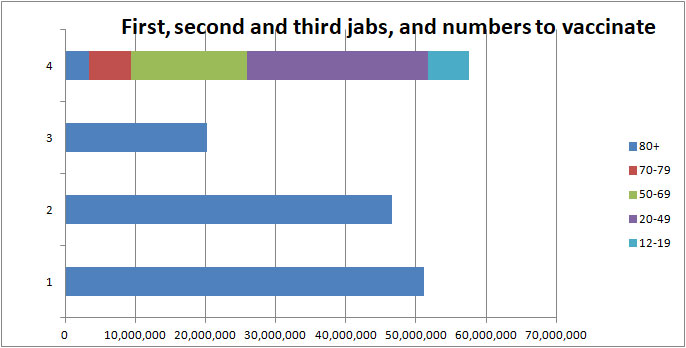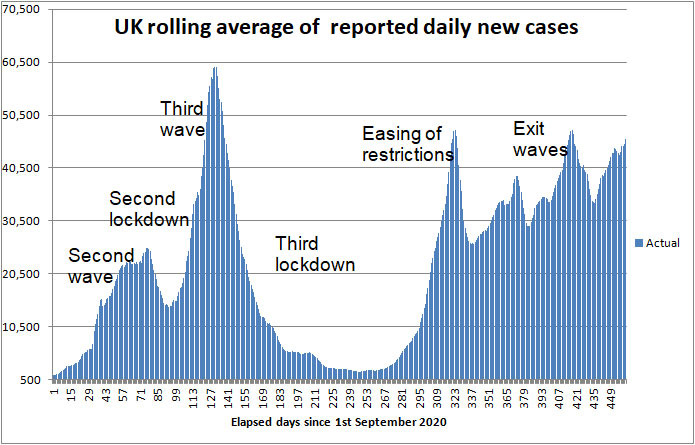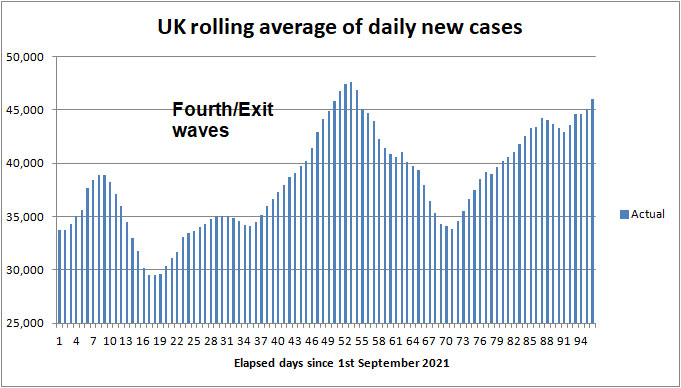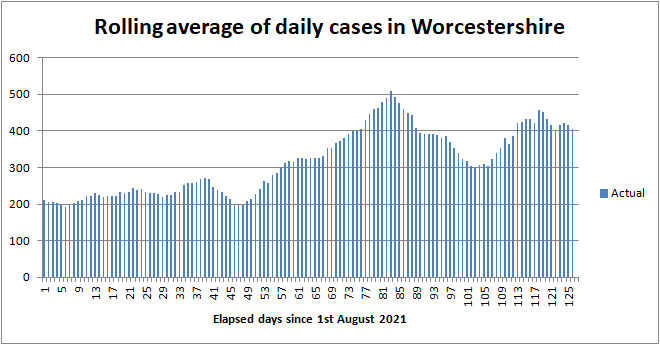
Angus and Rosemary's Miscellany
of Malvern - Other Resources
|
Coronavirus (COVID-19) epidemic weekly update for Malvern Seniors5th December 2021 GET VACCINATED AND TAKE CARE AS VIRUS STILL WIDESPREAD New variant of concern named Omicron PreambleWe keep an eye on the published government figures and monitor the media to asses the level of risk for Seniors in the Malvern Hills district. We also provide links to where further information can be found. This page is normally updated every Sunday between 1800 and 2400 hours GMT. Information about Coronavirus can be found on the NHS website: https://www.nhs.uk/coronavirus ContentsFurther information: About the Zoe COVID symptom study About the NHS contact tracing app SummaryCases have continued to bump along at a high level in the UK, rising only slightly this week, while daily hospital admissions and deaths have flat-lined. While cases remain high, double vaccinated Seniors are advised to continue taking precautions to reduce the risk of catching the virus; such as regular hand-washing, wearing a face covering where recommended, continuing with sensible distancing, and avoiding crowded situations. Double vaccinated individuals can catch the Delta variant of COVID and pass it on to others. Some may feel very poorly, but thankfully most should not need treatment in hospital or die. Those who are still unvaccinated are strongly urged to get vaccinated. Lateral Flow Device kits which only require a nose swab can be used to test for COVID at home, for example before visiting relatives at Christmas and New Year. The best present for Seniors is to get a booster jab before Christmas. Two weeks after their (third) booster jab most people's resistance to COVID-19 should be greatly increased. Triple jabbed Seniors should be as well protected this Christmas as ever they will be, so may feel less need for caution. Don't forget your flu jab as it is expected there could be a greater chance of dying were an unfortunate individual to catch flu and COVID at the same time. A local summary of COVID cases can be found on the Worcestershire Coronavirus Dashboard. Note: use the arrow <> buttons at the bottom of the Dashboard screen to move between pages. Click for Worcestershire County Council COVID-19 news Click for Simple Summary of Malvern numbers on the Coronavirus dashboard
Omicron variantA new variant of concern has been found in South Africa named Omicron and cases are now being found across the world including the UK. Scientists have yet to establish the threat, but the government is sufficiently concerned to impose some new restrictions and recommendations (see commentary). Click to go to our annex/commentary Omicron could either turn out to be a damp squib and fizzle out, or may overtake the Delta variant in coming weeks. Scientists will probably not know the infection/fatality ratio of the Omicron variant before New Year, but experts appear hopeful booster vaccinations will at the very least offer protection from serious illness and death.
How to get vaccinatedThe effectiveness of the vaccines falls slightly over time so the most important thing everyone can do now is get a booster jab. All those aged 70+ years should have received either an email, letter or text message from their GP surgery, or a letter from the NHS inviting them to book an appointment for their booster. Under the government's plan to deal with the Omicron variant, all those aged 18+ years will become eligible for a booster 3 months after their second dose, and the NHS has been tasked to offer everyone the chance to book an appointment by the end of January 2022, stepping down in age groups from the oldest first to the youngest. The public are asked to wait to be contacted by the NHS, when it is their turn, before booking an appointment. Boosters can still be had without an appointment at the Three Counties Show Ground by those whose second dose was 6 months ago. See the NHS website for opening times and vaccine availability: Alternatively click this link for more information and to book a vaccination on-line: Book a Coronavirus vaccination - NHS (www.nhs.uk) Note: the immuno-compromised may be offered a third jab as part of their primary course, followed by a booster 3 months later. More about vaccinationsPlanOn the 19th November 2021 the JCVI issued new recommendations accepted in Parliament by Sajid Javid. The plan is to vaccinate fully as many people as possible before the Omicron variant becomes dominant in the UK.
There appear no plans at present to vaccinate those aged 5 - 11 years. The new arrangements are still being worked out, but once these have been set out, if you are worried and feel you have been missed out you should contact your GP. The government plans a big push to step up the vaccination rate for example by opening new vaccination centres and increasing payments to GPs and pharmacies. VaccinometerSo that you can see the overall progress of the vaccination programme in the UK, our bar chart below shows the total number of:
Vaccinometer as of 5th December 2021 The population of the UK aged 12+ is about 58M, so were everyone in that age group to be vaccinated under the new plan the lower two blue lines showing 1st and 2nd doses should ideally reach 58M. Currently there are about 7M in this age group who are unvaccinated, which is a lot, and 4M still to get their 2nd dose. In comparison, if children aged 11 years and under are counted, the total population of the UK is roughly 66M. Achieving herd immunity is now thought to be impossible as vaccinated individuals can still catch COVID-19 and pass it on to others; nevertheless vaccination is most important to protect as many individuals as possible of all ages from debilitating long term loss of smell and taste, Long COVID, serious illness, and death. Click for NHS video warning young people of the dangers of the virus for the unvaccinated. Vaccination statistics can be found on the Vaccination tab of the Coronavirus Dashboard. Click for BBC report - Covid vaccine: How many people are vaccinated in the UK Booster jabsThe number of booster jabs given in England can be found in a spreadsheet on the NHS England website. Look in the data section for the COVID-19 daily announced vaccinations Excel file which gives a breakdown of jabs by region and age. Click for NHS COVID-19 vaccinations To date about 46M have had two doses, and 20M booster doses have been administered, suggesting up to 26M to boost in the UK. Assuming 3M doses per week that could take about 9 weeks, and allowing for one week lost over Christmas, then it should certainly be possible to boost all eligible adults by the middle of February. Vaccinations WorldwideA chart of the worldwide vaccination situation can be found on the Our World in Data website. Click for worldwide statistics Note: click the country list on the left hand side of the screen to add or remove countries from the chart. The UK did well to start with but has fallen a little behind many other countries. For example Portugal has double vaccinated 88% of its population, Singapore 92% and Malaysia 77%, compared to 68% in the UK. Australia has overtaken the UK with 73% fully vaccinated and may soon open its borders to the fully jabbed. Israel has already boosted its population. In Singapore all age groups are now eligible for a booster 5 months after their second dose. We imagine the UK is ahead of the EU booster programme.
|
| Districts of Worcs | Cases | Weekly increase | Population |
| Bromsgrove | 16,506 | +483 | 98,529 |
| Malvern Hills | 8,071 | +312 | 77,545 |
| Redditch | 14,409 | +416 | 85,317 |
| Worcester | 14,891 | +587 | 103,542 |
| Wychavon | 16,654 | +639 | 126,240 |
| Wyre Forest | 14,382 | +436 | 100,957 |
| TOTAL | 84,913 | +2,873 | 592,130 |
| COMPARE WITH | |||
| County of Hereford | 22,632 | +739 | 195,000 |
| Leicester (city of) | 67,894 | +1.288 | 400,000 |
Cumulative cases reported by PHE in Worcestershire to 5th December 2021
Note: the weekly increase is indicative; the seven day average by area, which varies day to day, is an alternative metric that can be found on the Coronavirus dashboard.
Cases in Malvern Hills by age group
On the cases tab of the Coronavirus dashboard you can either select the county of Worcestershire or a local authority such as the Malvern Hills, and there you can find a heat map showing cases by age group over time and a chart comparing the number of cases under 60 years with those aged 60+.
The latest figures show the infection rate in those aged 60+ years is 6 times lower than those aged under 60, whilst the heat map shows since the autumn the infection rate has been highest in those of school age.
The bad news is that the case rate for those aged 60+ has increased by about 25% in the last week in the Malvern Hills.
Click for cases by specimen date age demographics in the Malvern Hills
Interactive maps
At the bottom of the Coronavirus Dashboard (daily update) page there is an Interactive Map which is coloured to show infection rates across the country.
Cases across much of England and Wales remain high.
Click for Interactive Map of COVID cases
Note: the Interactive Map works on desktop PCs but it's possible you may encounter difficulties using a tablet or smartphone.
Recent weekly cases to 29th November are: North Malvern 39; Malvern Link 16; Pickersleigh 15; Barnards Green 23; Malvern Wells and Priory 22; Callow End and Hanley 29; Upton and Welland 35.
Another map can be found on the Zoe COVID Study website indicating extrapolated cases based on reports from those using the Zoe app.
Click for People with COVID (estimated from the Zoe app)
Number of deaths
Statistics on COVID deaths are published by Public Health England, The Office of National Statistics, and NHS England.
PHE figures
Public Health England reports that the cumulative total of COVID (28) deaths in UK hospitals and care homes rose by 830 in the last week to 145,605 while the daily average flat-lined at about 120 deaths per day.
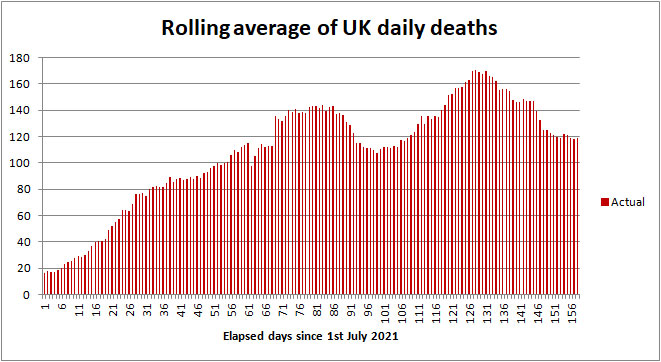
COVID-19 death rate 1st July to 5th December 2021
Click to view the UK government Coronavirus Dashboard
Since England emerged from lockdown on 19th July about 17,000 people have died of COVID-19; mostly the elderly.
In comparison averaged over recent years 1,700 people die daily from all causes, so COVID deaths now account for about 7%.
ONS figures
The Office of National Statistics (ONS) separately reports registered deaths in England and Wales where COVID-19 is mentioned on the death certificate. The ONS figures lag the PHE figures by 10 - 14 days and do not include Northern Ireland and Scotland.
Click for national ONS data on deaths (Excel spreadsheet)
The ONS figures are broken down by District providing a glimpse of where deaths are occurring. The provisional cumulative total of COVID related deaths in Worcestershire reported by the ONS up to 19th November 2021 (week 46 of 2021) is shown below.
Note: the numbers are from the ONS Death Registrations-Pivot table
| Districts of Worcs | Deaths 2020 |
Deaths 2021 |
Week 46 | Population |
| Bromsgrove | 164 | 130 | 3 | 98,529 |
| Malvern Hills | 61 | 96 | 3 | 77,545 |
| Redditch | 108 | 97 | 1 | 85,317 |
| Worcester | 87 | 127 | 0 | 103,542 |
| Wychavon | 157 | 146 | 0 | 126,240 |
| Wyre Forest | 171 | 127 | 2 | 100,957 |
| TOTAL | 748 | 723 | 9 | 592,130 |
Provisional cumulative COVID-19 deaths registered by ONS to 19th November 2021
In week 46 there was 1 death in a care home and 2 in hospital in Bromsgrove; 1 death at home and 2 in hospital in the Malvern Hills; 1 death in hospital in Redditch; and 1 death at home and 1 in hospital in Wyre Forest.
In England and Wales 949 COVID-19 related deaths were reported in the week to 19th November, 69 less than the week before. Of these 66 were in a care home, 92 at home, 10 in a hospice, 774 in hospital and 7 elsewhere.
Note: summation of rows 9 to 339 of the ONS deaths Registrations-Pivot table.
The provisional UK COVID-19 death toll (as reported by PHE and ONS) for all weeks of the epidemic can be found on the Deaths tab of the Coronavirus Dashboard.
NHS England figures for Worcestershire
The table below shows latest COVID deaths in Worcestershire hospitals reported by NHS England on 3rd December 2021.
| Worcestershire | Cumulative deaths | Past week |
| Acute hospitals | 891 | 7 |
| Care hospitals | 64 | 0 |
| TOTAL | 955 | 7 |
Click for NHS COVID-19 total announced deaths
Click for Summary of Malvern numbers on the Coronavirus dashboard
Risk of COVID-19 death by age band
NHS England provides an analysis of COVID-19 deaths in hospital in England and Wales by age band. Shown below is a breakdown of deaths for the period 1st August 2021 to 25th November 2021 when the daily death rate fell to 125.
| Age band | Number of deaths | % of deaths |
| 0 - 19 | 29 | 0.3 |
| 20 - 39 | 157 | 2 |
| 40 - 59 | 1,058 | 11 |
| 60 - 79 | 4,062 | 43 |
| 80+ | 4,134 | 44 |
Relative risk of COVID-19 death by age band
Those aged 60+ years account for 87% of deaths compared to 92% last year, but remember that due to vaccination the death rate as a proportion of new cases is five to ten times lower than in 2020.
The majority of these deaths are likely to be of the vaccine-hesitant, those with underlying conditions such as Diabetes, the frail, and those that are immuno-compromised. Pregnant mothers, the overweight and deprived individuals with a poor diet are also said to be at increased risk.
An NHS leaflet offered to patients being admitted to hospital suggests we are at higher risk of complications from COVID-19 infection if we have one or more of the following conditions:
-
Age over 70 or Male over 50;
-
Lung problems (including asthma, COPD, emphysema, bronchitis, bronchiectasis;
-
Heart disease
-
Diabetes
-
Chronic kidney disease
-
Liver disease (eg hepatitis, cirrhosis)
-
Brain or nerve problems (eg Parkinson's disease, motor neurone disease, multiple sclerosis, cerebral palsy)
-
You have a condition that increases the risk of infection
-
Take medication that affects the immune system, (eg steroids)
-
Very obese (BMI over 40)
-
Pregnancy
Some COVID deaths are of the fully vaccinated elderly, but remember that broadly speaking we are ten times more likely to die of something else; so don't be over-concerned.
Healthcare numbers
The UK government Coronavirus Dashboard includes important information about healthcare statistics and NHS bed occupancy.
| Hospital COVID cases (UK) | Number | Change since last week |
| Patients currently in hospital | 7,373 | -260 |
| Patients on ventilation | 895 | -30 |
| Patients admitted daily | 812 | +44 |
Headline summary of patients in hospital reported on 5th December
Hospital admissions have roughly flat-lined in recent weeks. The number of hospital beds occupied by COVID patients is about 18% of the peak last January.
 Worcestershire hospital beds
Worcestershire hospital beds
Tabulated figures for bed occupancy in Worcestershire Acute and Care hospitals can be found on the NHS England website.
Click for NHS England COVID-19 Hospital bed Activity
A summary can be found on the UK government Coronavirus Dashboard which reports on 30th November there were 58 COVID-19 patients occupying Worcestershire Acute Hospital beds, of which 5 were ventilated beds; roughly 21% of the peak experienced last January.
Between 22nd November 2021 and 28th November 2021, 42 patients went into hospital with coronavirus. This shows an increase of 10% compared to the previous 7 days, but on average the number of occupied beds is remaining fairly level.
Note: Healthcare statistics can be found on the Healthcare tab of the UK Coronavirus Dashboard. At the top of the page where it says Healthcare in United Kingdom, click the drop down arrow to select Area Type as NHS Trusts, and Area Name as Worcester Acute Hospitals.
Click to view Worcester healthcare figures
Alternatively,
Click for Summary of Malvern numbers on the Coronavirus dashboard
Forecast for the week ahead
Trends suggest that during the next seven days (up to 12th December) the cumulative total of UK COVID-19 cases reported by PHE on the Coronavirus Dashboard could increase by 310,000 towards 10,775,000 with the 7 day rolling average of daily new cases hovering around 44,000.
In Worcestershire up to 2,800 new cases of COVID-19 can be expected, and 300 cases in the Malvern Hills district.
There has been no evidence yet of cases beginning to fall exponentially.
We expect the number of UK COVID (28) deaths will increase by about 840 towards 146,450 during the 7 days ending 12th December 2021, with the average daily death rate hovering around 120 deaths per day. These are 'baked in' deaths of those already infected which cannot be avoided.
In the county of Worcestershire, assuming a 0.2% death rate, the 2,873 new cases this week may translate to 6 COVID deaths per week by the end of December.
Daily hospital admissions are expected to remain fairly level in the range 750 - 850.
Longer term outlook
The outlook beyond Christmas is unpredictable following the emergence of the highly infectious Omicron variant in Africa which could overtake Delta early in the New Year.
For the current scenario, based on the Delta variant remaining dominant and becoming endemic, we had been expecting to see a gradual downturn in daily hospital admissions and deaths during the next 3 months as those aged 40+ years received booster jabs, and children were either vaccinated or gained immunity following infection by COVID-19.
The timing of this was itself uncertain depending on the speed of the vaccine rollout and take-up; tag on a week or so for the vaccine to take effect, a further week for the increased resistance to infection to impact hospital admissions, and a further two weeks for this to be reflected in the number of daily deaths, then we were looking towards the end of December to see a marked improvement in the figures.
That would coincide with the Christmas and New Year holiday when the reporting of figures is likely to be delayed, so reliable estimates of trends might not be obtainable until early January.
The emergence of the Omicron variant of concern in Africa may not greatly affect the UK figures for hospitalisations and deaths in December but could affect trends in January and beyond.
The likely new scenario involves Omicron overtaking Delta and becoming dominant. By the New Year scientists should have a better idea about the reproduction rate of Omicron, the severity of illness in different age groups, and the level of protection offered by the current vaccines.
The latest modelling from University College London, based on the Delta variant, suggests the 7-day average of daily deaths of about 150 per day could fall slowly over the next weeks, reaching a minimum of about 25 per day in April 2022.
Click for UCL Long-term forecasting of the COVID-19 epidemic
This and other models will need to be rerun in January once the outline parameters of the Omicron variant are known, and as they are refined, and taking account of the accelerated roll-out of boosters.
For a fixed level of vaccination, daily cases have been a signpost to whether daily hospital admissions and deaths are going to go up or down. Based on our heuristic 'rules of thumb' hospital admissions, and deaths during December were expected to follow daily cases very roughly in the ratio:
-
Hospital admissions 1:50 of daily cases reported by PHE, lagging by 8 days.
-
Deaths 1:300 of daily cases reported by PHE, lagging by about 20 days.
-
UK Hospital bed occupancy - one fifth of daily cases, lagging by up to a month.
As boosters are rolled out, a gradual improvement in these ratios is anticipated in the next month or so, but thereafter the situation could change, for better or worse, if the Omicron variant overtakes Delta.
Advice for Seniors
 Recently
there have been no more than 10 COVID related deaths per week in Worcestershire
which has a population of 600,000 so we judge the
risk of death for fully vaccinated
Seniors to be
fairly
LOW while the risk of Long COVID might be MODERATE;
see our annex and riskometer opposite.
Recently
there have been no more than 10 COVID related deaths per week in Worcestershire
which has a population of 600,000 so we judge the
risk of death for fully vaccinated
Seniors to be
fairly
LOW while the risk of Long COVID might be MODERATE;
see our annex and riskometer opposite.
7M people remain unvaccinated in the UK. Remember, if you are elderly, have not been vaccinated, and were to catch COVID there is a significant chance that you will either die or your long term health may be seriously damaged, so if you are able get both doses of your vaccine and your booster and continue to take care of yourself and those you love. Also encourage others to be vaccinated.
Click for our risk of death table (for those who have not been vaccinated)
Like Health Minister Sajid Javid and Sir Kier Starmer, it is quite possible, despite a second jab, for Seniors to become ill with COVID-19; some might have mild symptoms like a common cold or hay fever, while others could feel very poorly, but few except the frail, vulnerable, and unlucky will need to be admitted to hospital.
In these increasingly uncertain times the simple safeguards to remember are to:
-
book your booster dose when you are contacted by either your GP or the NHS; don't worry if you have to wait a week or two to get an appointment; two weeks after the booster most people should be well protected from severe illness caused by the Delta variant and most probably Omicron.
-
wash your HANDS thoroughly, using soap and hot water, for 20 seconds, including after handling deliveries to your home, to kill virus picked up from contaminated surfaces see note 1;
-
wear a FACE covering when unavoidably near other people for example when shopping, in health-care settings, and when using public transport;
-
SPACE at least 2 metres from people you don't feel safe with see note 2;
-
preferably socialise with friends and other households outdoors in the FRESH AIR else, if you are indoors, either ventilate by keeping windows open as far as is practicable or put a HEPA air purifier in the room;
-
avoid crowded indoor settings and minimise TIME near strangers;
-
self-isolate and take a test if you feel unwell with cold or flu like symptoms; according to the Zoe COVID Study the current top five symptoms amongst the double vaccinated and children, in order of prevalence, are said to be headache (73%), runny nose (73%), sneezing (59%), sore throat (53%), and cough (49%), which are often hard to distinguish from a common cold - you might alternatively suffer from fever with a temperature of up to 103 deg F, and a reduction in sense of taste.
-
respect others and give them space.
Notes:
1) Wash your hands thoroughly before touching your face to avoid transferring virus from contaminated surfaces to your mouth, eyes and nose. If outdoors use an alcohol based hand gel.
2) Two metres is further than you think - roughly an arm and a walking stick away.
3) The COVID Symptom Study people suggest that if you have symptoms of a common cold there is currently a 1 in 3 chance you might have COVID.
4) If you are attending a festive event consider taking a Lateral Flow test before you go to check you are not taking COVID to the party.
5) If you are organising a festive event, ask those attending to take a Lateral Flow test before they go.
6) Depending on your circumstances, think about attending a carol service or pantomime with lots of children present who may be spreading the virus.
Annex
Commentary
You will see that this web page has been revamped with the addition of a contents, and the sections about getting a test etc moved from the preamble to the end.
This week
On Monday The Malvern Gazette reported the sad death of Glynn Steel aged 54 from Coronavirus. His was an unnecessary death, as he had refused vaccination. This follows the death of an elderly man in Malvern who was also unvaccinated. These cases are yet another warning for the vaccine-hesitant to step up and get vaccinated.
The JCVI held a press conference led by Prof Jonathan Van Tam recommending that all those aged 18+ years should now become eligible for a COVID booster jab 3 months after their second dose, and that those aged 12 - 15 years should become eligible for a second dose three months after their first dose.
Click to watch JCVI COVID-19 press briefing on 29th November 2021
Soon after Sajid Javid spoke in parliament announcing and accepting the JCVI recommendations. The government now plans to accelerate the rollout of booster shots to counter a possible threat from the Omicron variant of COVID-19.
On Tuesday the PM held a news conference, supported by Health Secretary Sajid Javid and Chief Executive of the NHS Amanda Pritchard, outlining plans to accelerate the booster programme.
Click to read PM opening statement at COVID-19 press conference: 30 November 2021
Click to watch PM's COVID-19 press conference:30 November 2021
The main thrust was that the NHS, supported by pharmacies, is to 'pull out all the stops' in order to offer those double jabbed and over 18 a booster shot by the end of January 2022.
Note that an offer of an appointment may not be the same thing as getting jabbed. Not everyone will accept, and a shortage of slots could mean the boosting of younger age groups running into February.
See BBC news report on Youtube 30th November 2021
Click to read BBC report: Who can have a booster jab and how can you get one
What might happen next
In the worst case, assuming there are now 100 cases of the Omicron variant in the UK, transmission is not slowed much by the vaccines, and the virus grows exponentially doubling every 4 days or so, daily cases would initially be masked by the Delta variant during the next fortnight; then cases of Omicron could be seen to surge approaching Christmas competing with and then overtaking Delta by New Year's day.
Of course, cases could rise more slowly and it is not yet known whether the new Omicron variant causes more severe illness, similar, or perhaps less than Delta.
Therefore all we can do for now is stick with present plans, keep an eye on the figures as Christmas Day approaches, and be prepared to modify our behaviour should that become necessary.
COVID video updates
The usual charts can be found in the Zoe COVID Study and Independent SAGE weekly updates.
Click to watch Tim Spector's Zoe COVID Study 2nd December update
In another video Tim seems unconcerned about the Omicron variant:-
Click to watch Tim Spector's briefing about the Omicron variant
The Independent SAGE weekly briefing starts with this week's data and goes on to discuss the arrival of the Omicron variant, and answer questions.
Click to watch Independent SAGE 3rd December video briefing
This week Dr John Campbell talks about the desirability of withdrawing the needle slightly when giving jabs (aspiration) to avoid injecting the vaccine into for example a vein, which could cause blood clots or serious side effects.
Click to watch Dr John Campbell's 3rd December video about aspiration
U3A
U3A groups are packing up for Christmas. The Social History group has decided to cancel its party.
Overseas travel
Due to the threat of the Omicron variant, all travellers arriving in the UK must once again take a PCR test and remain isolated until a negative test result is obtained.
In addition from Tuesday, travellers must have evidence of a negative pre-departure LFD or PCR test.
That has upset the travel industry and is probably more a gesture to appease the Labour Party as the Omicron variant is already here and spreading within the community.
Click for BBC report Omicron: What are the new Covid rules for travelling to the UK
Tighter controls apply to those arriving from red list countries; Nigeria has been added to the list.
Click for red list of countries and territories
If you have been in a country or territory on the red list in the 10 days before you arrive in England, you will only be allowed to enter the UK if you either:
- are a British or Irish National
- have residence rights in the UK
If you live in England, you should not travel to countries or territories on the red list.
From 10th January 2022, travellers to the EU may have to show evidence of a booster vaccination if 9 months have elapsed since their last jab.
List of vaccines
Here is the updated list of COVID-19 vaccines ordered by the UK. It looks as though for now the government has settled on Pfizer as first choice with Moderna second and Astrazeneca held in reserve.
Valneva has been cancelled, and approval has not yet been sought for using Novavax in the EU and US although approval has been sought for use in third world countries.
For two doses plus boosters, only about 200M doses will be needed in 2021 and Jan/Feb 2022 for the population of the UK. The government has now signed deals to buy 114 million additional doses of the Pfizer (54M) and Moderna (60M) vaccines to use in 2022 and 2023.
The press announcement goes on to say that 60M doses of Novavax vaccine are expected to be delivered in 2022 and 7.5M doses of GSK/Sanofi, so there seems no intention to cancel these late arrivals.
Click for Guardian report - Novavax expected to be become fourth Covid vaccine available in UK
| COVID-19 vaccine | Doses ordered (million) | Status |
| Pfizer BioNTech, two dose, -70 deg C | 40+60+35 | Approved, deliveries continuing, made in Belgium (EU). An additional 60M doses have been ordered for booster shots for the most vulnerable in the autumn. A further 35M doses were ordered in August 2021 for delivery in 2022. |
| Astrazeneca, two dose, fridge | 100 | Approved for those aged 30+ years; deliveries continuing. Batches made in UK, Belgium and India. |
| Moderna, two dose, -20 deg C | 7+10 | Approved. First deliveries to Wales and Scotland 7th April 2021 then England 13th April; mainly for those aged under 50 years awaiting vaccination. |
| Valneva, two dose | 60+40 order cancelled |
A jab from French company Valneva will be made in Livingston, West Lothian, Scotland. Order cancelled September 2021. Delivery had been expected to start in second half of 2021. |
| Janssen, single dose | 20 | Approved, a jab from Belgian firm Janssen, owned by Johnson and Johnson; UK approval 28th May. Order reduced from 30 to 20M. |
| Novavax | 60 | A jab manufactured by US firm Novavax being made in Stockton-on-Tees UK; phase III trials complete, but approval has not yet been sought in EU and US. Glaxo Smith Kline (GSK) contracted to fill and package vials. Delivery expected in 2022. |
| GSK Sanofi | 60 | Some delay due to adjusting the formula to give better protection to the elderly; expected approval and delivery of 7.5M doses in 2022. |
| Curevac | 50 ? | Contract placed with German company Feb 2021. Possible source of new variant vaccine, but disappointing trial results. Future uncertain. |
Table of vaccines ordered by the UK government
Present rate of new cases and risk
The average rate of infection per 100,000 population per week is shown in the following table.
| Region | Case rate |
| England | 461 |
| Wales | 492 |
| Scotland | 339 |
| Northern Ireland | 627 |
| Worcestershire | 487 |
| Malvern Hills | 431 |
Seven day Case Rate per 100,000
The case rate is about the same as last week. Scotland is doing best and NI worst.
As a yardstick we suggest a figure of below 10 can be considered LOW, so there is a long way to go.
Based on back of the envelope sums in earlier blogs, the probability of fully vaccinated Seniors, without underlying conditions, catching and dying from COVID-19 is now possibly somewhere in the range 1 in 1,000 to 1 in 10,000 per year so we judge the risk fairly LOW compared to the risk of dying from other causes. Perhaps as many as 3% to 5% of people who catch COVID suffer from Long COVID so that risk might be assessed MODERATE.
The risk of death from Coronavirus for unvaccinated children and healthy teenagers is said to be small so for them the risk is LOW.
How to request a COVID test
In order to protect others it is important to get a test and self isolate if you feel unwell with either classic COVID symptoms, or cold and flu like symptoms which can be caused by the Delta variant.
There are now two types of test you can get. The more accurate PCR test involving a throat and nose swab which is sent to a laboratory for analysis and the Lateral Flow Device test.
Click for government guidance on types of tests
Getting a PCR test
Click the link below for information on how to get a free NHS PCR test if you think you may have Coronavirus:
https://www.gov.uk/get-coronavirus-test
We feel the website discourages people from seeking a PCR test who don't have all the classic symptoms. If you feel strongly enough, press on answering the questions so as to get your PCR test.
In case of difficulty you can try phoning the Coronavirus contact centre by dialing 119.
Alternatively settle for a 'Nasal swab' Lateral Flow Device test in the comfort of your own home (see below).
According to Google there is a 'drive through' COVID testing station at County Hall near the Countrywide Centre, and a 'walk through' at Pershore.
There is also a COVID testing station at the Worcester Royal Hospital for screening patients before admission.
If you cannot get to these you can order a home PCR test kit.
If you test COVID positive you should self-isolate for 10 days.
Getting a Lateral Flow Device test
Lateral Flow Device tests (LFD) can either be booked at Claremont Pharmacy in Barnards Green, Evans Pharmacy in Malvern Link, or taken at home.
The test is intended to screen those who do not show the classic symptoms of COVID-19 and provides a means to check you are 'virus free' at home - either before visiting an elderly person, going to work, or attending a crowded event. It also provides a means to check whether or not you have Coronavirus if you are feeling poorly with cold and flu like symptoms.
 You
can collect home test kits,
for example packaged as the COVID-19 Self-Test (Rapid Antigen Test) in boxes
of 7 tests, from Malvern library, the Co-op, and most pharmacies such as Boots and Murrays in Church
Street, Claremont House and Lloyds in Barnards Green, Murrays at Prospect
View, Evans and Murrays in Malvern Link, and Boots and Morrisons on the
Enigma Retail Park.
You
can collect home test kits,
for example packaged as the COVID-19 Self-Test (Rapid Antigen Test) in boxes
of 7 tests, from Malvern library, the Co-op, and most pharmacies such as Boots and Murrays in Church
Street, Claremont House and Lloyds in Barnards Green, Murrays at Prospect
View, Evans and Murrays in Malvern Link, and Boots and Morrisons on the
Enigma Retail Park.
If collecting from a pharmacy you now have to go on-line and get a collection code to present to the pharmacy in order to obtain a pack of 7 tests. This involves giving NHS Test and Trace your email and/or mobile phone number and address.
http://www.gov.uk/get-collect-code
The LFD now comes in two versions.
-
The Throat and Nose Swab kit;
-
The Nose Swab only kit (Orient Gene, Acon Flowflex and MP Biomedicals).
(Lateral Flow Device cassette shown on the right).
ACON Flowflex comes in a blue and white pack.
Orient Gene comes in a green and white pack.
MP Biomedicals come in a blue, white and grey pack.
Click for instructions for using the LFD test kits
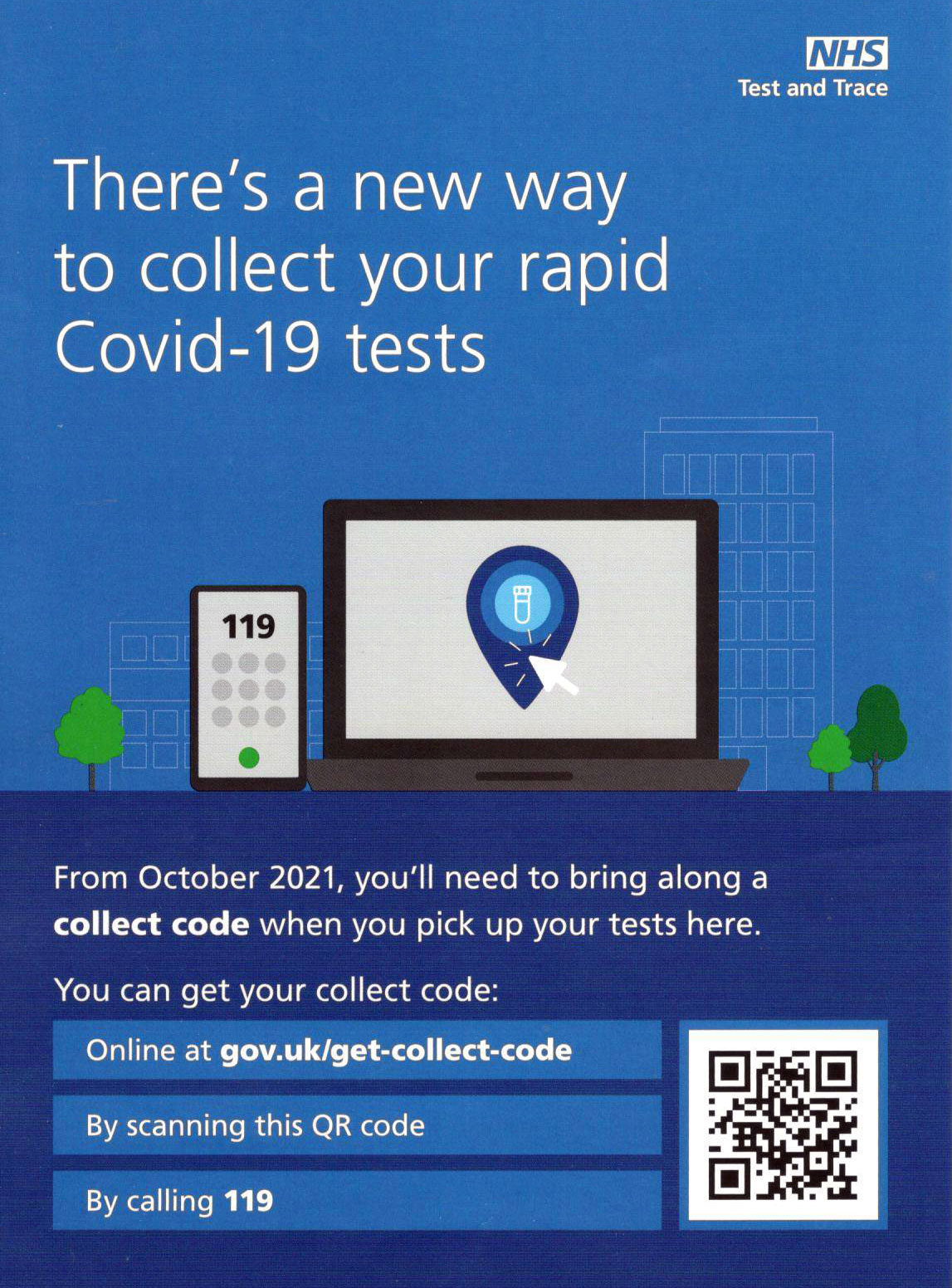
Leaflet at Boots the Chemist
The new Nasal swab test kit which only requires a nose swab is the easiest to use and the best one to get but it is not yet widely available. On 10th November we found Boots in Church Street and Malvern Library were still supplying the old Throat and Nose kit; Murrays in Church Street had the new kits and Malvern library thought the library in St John's Worcester might have the new kits.
Click for NHS information on Rapid Lateral Flow Test sites and collection sites in Malvern
Hint: to see the list, click on 'filter' and then 'pick up sites for test kits' checkbox.
Click for WCC info about Lateral Flow Tests
In our opinion, many Seniors will find the classic Throat and Nose Swab home test kit difficult to use as you need to rub the tonsils or thereabouts with the swab-stick without touching the tongue, teeth, cheeks, gums or any other surface before swabbing the nose. Doing this standing in front of a mirror on your own without gagging while holding a torch in the other hand, won't be easy unless you have a steady hand and good eyesight.
The Nose Swab kit is by far the best one for testing yourself at home.
If you test COVID positive you should isolate and take a more accurate PCR test to confirm the result.
NHS Test and Trace want people to report the result of their home LFD tests within 24 hours at:
www.gov.uk/report-covid19-result
This helps NHS Test and Trace monitor where the issue of the free LFD tests is proving most effective and the spread of the disease.
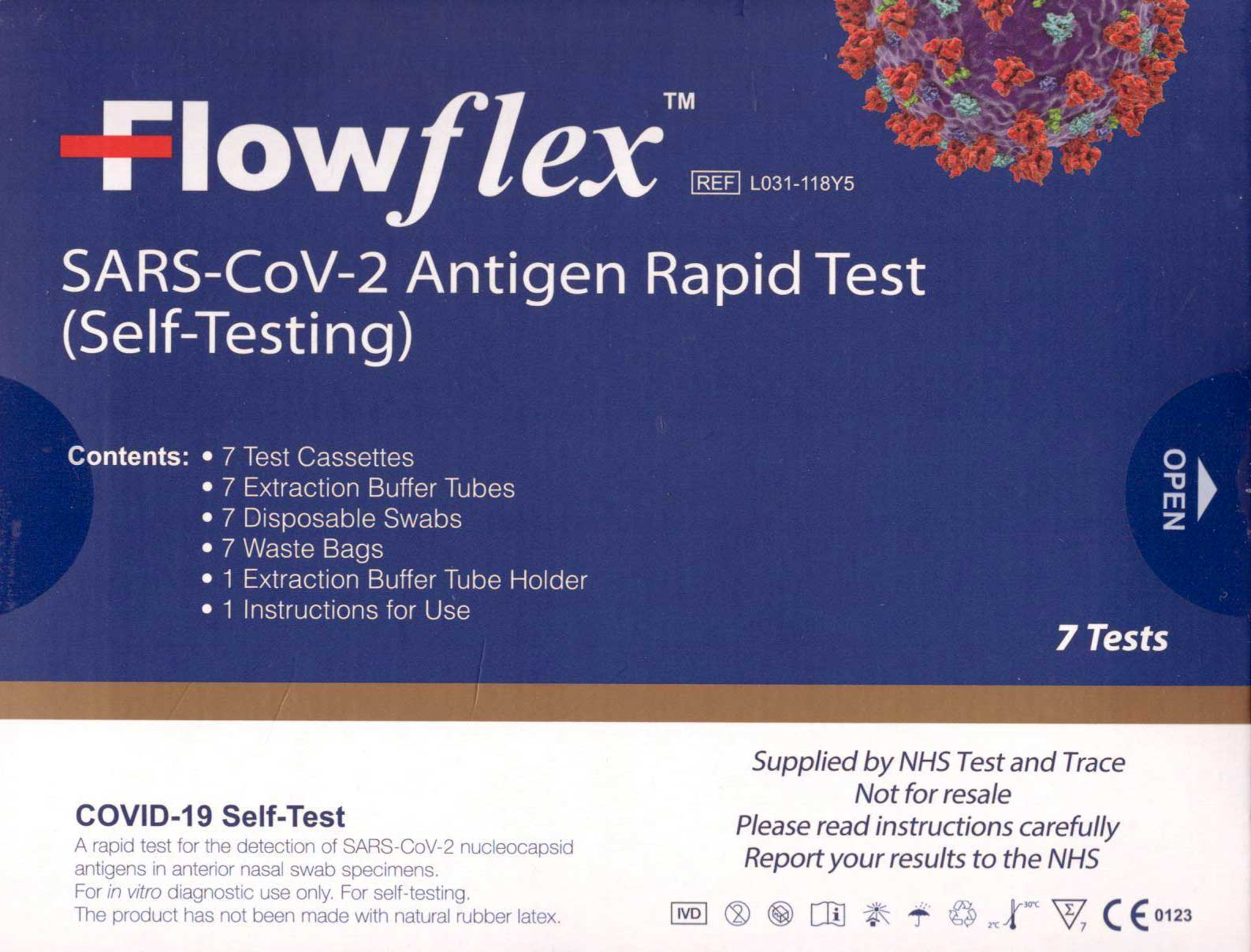
Nose swab home test kit obtained from Murrays
About the COVID Symptom Study app (Zoe)
 You
can help others by downloading the COVID Symptom Study app onto your
smart-phone or Ipad and reporting how you feel either daily, or as you are
able. Note there is no desktop PC version for Windows.
You
can help others by downloading the COVID Symptom Study app onto your
smart-phone or Ipad and reporting how you feel either daily, or as you are
able. Note there is no desktop PC version for Windows.
For further details click this link: https://covid19.joinzoe.com
The Zoe app, which is easy to use, allows you to report whether or not you are feeling well and if you have had a test for COVID. This helps Kings College London monitor the spread and symptoms of the disease and give advice to government. This is an important source of data as we progress through the EXIT wave.
There are questions allowing you to enter your vaccine type and whether any side effects; this now includes boosters and flu jabs.
About the NHS COVID-19 contact tracing app (England)
Release of the NHS COVID-19 contact tracing app for Apple and Android smartphones was announced on 24th September 2020.
Click this link for NHS Coronavirus app information
If you have been close to someone who has tested COVID positive, your smart-phone will be pinged and you will be advised to self-isolate
From 16th August fully vaccinated individuals don't need to self-isolate. However if you are feeling poorly and get pinged it is recommended you take a COVID test, and self-isolate if the result is positive.
Bear in mind double vaccinated individuals can still catch the Delta variant of COVID and pass it on to others.
About the NHS app and Covid Pass
You will need the NHS app installed on your smartphone and be registered with the NHS in order to display your vaccination status, for example when travelling abroad.
Note: this is not the NHS COVID-19 app
If you don't have a smartphone you may be able to login from a PC to obtain a printed copy.
Login from a desktop computer or laptop
You can use your NHS login when signing in to report the result of Lateral Flow Device tests taken at home.
Summary of Links
Symptoms
Article about the effects of Coronavirus on the human body
Reporting and how to obtain a test
How to get a test
https://www.nhs.uk/coronavirus
About joining the Zoe COVID Symptom Study:
Guidance
UK government Coronavirus guidance
COVID-19 Response: Autumn and Winter Plan 2021 for England
COVID Alert states
Guidance on UK COVID-19 alert level methodology: an overview
COVID-19 Alert Level lowered to 3 on 10th May 2021
Tiers
Guidance on tiers: what you need to know
Government postcode checker to find tier for other areas
Statistics
UK government Coronavirus Dashboard
Coronavirus Dashboard Interactive Map
ONS data on deaths in England and Wales (Excel spreadsheet)
NHS England COVID-19 Daily Deaths
NHS England COVID-19 Hospital Admissions
NHS England vaccination statistics
Worcestershire Coronavirus Dashboard
Worcestershire COVID-19 Vaccinations Dashboard
HSA COVID-19 vaccine weekly surveillance reports
A glimpse of the worldwide vaccination situation can be found on the Our World in Data website.
Click for chart showing % vaccinated
Modelling
A forecast of the progression of the COVID-19 epidemic can be found on a University College London (UCL) website.
Click for UCL Long-term forecasting of the COVID-19 epidemic
A projection of the future COVID-19 death toll and daily deaths can be found on The Institute for Health Metrics and Evaluation website.
Click for IHME projection of COVID-19 deaths
Reports
ONS Coronavirus (COVID-19) Roundup
The bigger picture
Worldometer summary of coronavirus cases worldwide
European Centre for Disease Prevention and Control info
https://www.ecdc.europa.eu/en/geographical-distribution-2019-ncov-cases
World Health Organisation info
Window on the USA
Centre for Disease Control (CDC)
American Association of Retired People (AARP)
Worcestershire
Help:
http://www.worcestershire.gov.uk/here2help
Worcestershire County Council COVID-19 information:
http://www.worcestershire.gov.uk/coronavirus
Here you will find a useful link,
'Website: Number of new cases by date in Worcestershire'
which displays interesting COVID charts and statistics for Worcestershire
Miscellaneous
Spanish Flu
Dr Jeff Kildea's commentary about the 1919 outbreak of Spanish Flu in Australia
Views of Martin McKee, Professor of European Public Health
Follow Martin McKee on Twitter
SAGE membership
Scientific Advisory Group for Emergencies (SAGE)
Scottish government:
Link to Scottish Government website
Link to Postcode checker for COVID restrictions by protection level in areas of Scotland
Welsh Government:
Guidance on COVID alert levels in Wales

The interpretations and opinions expressed are our own
Last updated 5th December 2021
 Blogs
>
Blogs
>